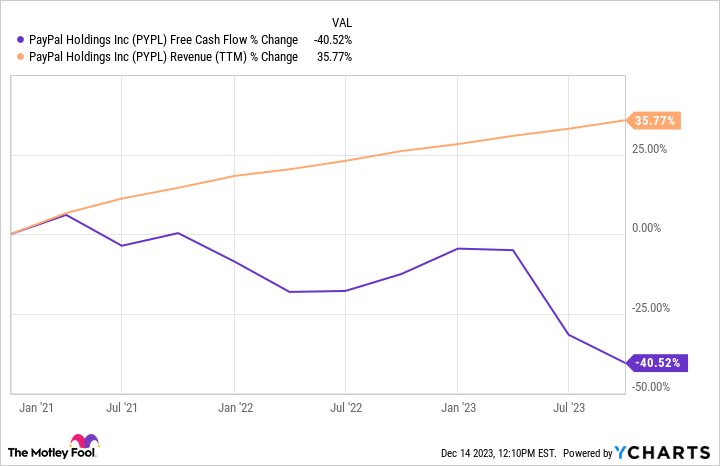In 2015, eBay spun off PayPal (PYPL -0.99%) into its own publicly traded company. As an investing novice at the time, I didn’t fully grasp how it worked. So I bought shares of eBay beforehand so that I’d own shares of PayPal on Day 1. After the spinoff, I sold the eBay stock.
My investment thesis for PayPal was simplistic back then. I simply saw that cash transactions were falling and that digital payments were rising, to PayPal’s benefit. And I also saw that the company generated a lot of free cash flow.
I figured PayPal’s top-dog position in a growing market would guide to much higher profits down the road, boosting the stock price.
I’ve left my PayPal investment completely untouched since 2015 — I haven’t sold, trimmed, or added to it. And at this point, I’ve held it longer than any other stock in my portfolio. But there’s one thing I’m looking at with this business right now that has me concerned. And I could consequently sell my shares in 2024 if current trends don’t reverse.
Waving a yellow flag for PayPal
Stocks tend to go up over the long term when profits boost. There are different ways to measure profitability, but free cash flow is often a good metric to look at. And for much of PayPal’s life as a public company, free cash flow increased.
That trend has reversed in recent years and has me concerned as a shareholder. As the chart below shows, revenue for PayPal is up almost 36% in the last three years, whereas free cash flow has declined considerably.
PYPL free cash flow data by YCharts; TTM = trailing 12 months.
The yellow flag that I’m waving might be illustrated even better by looking at a five-year table. Below, I’ve included revenue, free cash flow, and the free-cash-flow margin.
| Metric | 2019 | 2020 | 2021 | 2022 | 2023* |
|---|---|---|---|---|---|
| Net revenue | $17.8 billion | $21.5 billion | $25.4 billion | $27.5 billion | $29.6 billion |
| Free cash flow | $3.5 billion | $5 billion | $5.4 billion | $5.1 billion | $4.6 billion |
| Free-cash-flow margin | 19.7% | 23.3% | 21.3% | 18.5% | 15.5% |
Data from PayPal. Chart by author. *2023 based on management’s full-year estimates.
With just a 15.5% free-cash-flow margin projected in 2023, PayPal is performing at a historically lackluster level. And if the free-cash-flow margin continues to deteriorate (as it has for a third straight year), then this stock might struggle to beat the market even though it has a low valuation.
Why are PayPal’s margins getting whacked?
Wading through cash-flow statements is extremely tedious when trying to pinpoint a problem. But something very big happened with PayPal’s business in late 2020: It launched buy now, pay later (BNPL) at checkout.
On the earnings call to converse financial results for the fourth quarter of 2021, management mentioned using its cash flow to fund its credit products, including BNPL. At the time, it said, “If we get to a point where we think those are getting too large and we are too dependent upon credit to where maybe it influences the durability of our earnings stream, then we’ll look at externalizing that.”
In other words, if PayPal started spending too much cash flow to fund credit, then it would look to outsource funding. This appears to be what has happened. And the company has now kept its outsourcing promise.
In June, PayPal reached a deal with investment firm KKR to fund its BNPL product. For PayPal, there’s an immediate benefit of $1.8 billion, which it will use to repurchase shares. But there’s hopefully a longer-term benefit as well: improved cash flows.
Looking to 2024
The financial technology space is competitive, and so offering a product that hurts margins could be necessary if customers demand it. In PayPal’s case, it has a large merchant customer base, and it says that BNPL helps with sales conversions. Therefore, BNPL seems admire a product that the company needs to offer to be competitive.
That said, PayPal’s profits do need to boost if the stock is going to perform better. And BNPL might have been the key thing holding profits down. Reaching an agreement with KKR, therefore, could be huge, and its free cash flow could rebound significantly in 2024.
If PayPal’s free cash flow doesn’t better in 2024, even with KKR’s help, then it might be time for me to advance on from my PayPal investment. But for now, I see a path toward improvement. So I continue to hold, as I’ve done for eight years now.
Jon Quast has positions in PayPal. The Motley Fool has positions in and recommends KKR and PayPal. The Motley Fool recommends the following options: short December 2023 $67.50 puts on PayPal. The Motley Fool has a disclosure policy.




